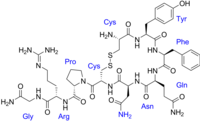
Photo from wikipedia
Cytochrome P450 1A2 (CYP1A2) plays important roles in the metabolism of many planar and aromatic drugs and also contributes to the bioactivation of aflatoxin B1 (AFB1) in vivo. To date,… Click to show full abstract
Cytochrome P450 1A2 (CYP1A2) plays important roles in the metabolism of many planar and aromatic drugs and also contributes to the bioactivation of aflatoxin B1 (AFB1) in vivo. To date, the structural basis for CYP1A2's preference to the planar substrates remains unclear. Herein, we investigated the structure-activity relationships for pig CYP1A2 catalyzing AFB1 and 7-ethoxyresorufin (7-ER). A molecular docking study was performed based on a constructed model of pig CYP1A2, which predicted the contributions of Thr-118, Thr-124, Phe-125, Phe-226, Leu-260, and Asp-313 to the substrate catalysis. Site-directed mutagenesis and kinetic analyses exhibited the common grounds: Phe-125, Phe-226 and Asp-313 were vital to AFB1 oxidation (including exo-epoxidation and 9A-hydroxylation) and ethoxyresorufin O-deethylation. Meanwhile, Phe-125 and Phe-226 formed CH/π interactions with AFB1/7-ER, and Asp-313 formed hydrogen bonds with them. Based on other published reports, this study further emphasizes the critical roles of Phe-125 and Phe-226 in recognizing the planar substrates. Our findings highlight the structural basis of pig CYP1A2 specifically catalyzing AFB1 and 7-ER, and may help to elucidate the underlying mechanism of CYP1A2's metabolic preference to the planar and aromatic substrates.